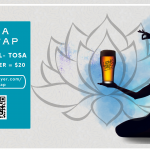Take it with a grain of salt

Judy Mayer-Kieckhoefer
It’s used for icy roads, to polish silver and as food preservative. It kills weeds and puts out fires! It’s used as a flavor enhancer and is one of our basic tastes. Salt is an essential nutrient responsible for regulating water balance and controlling muscle and nerve function. It plays a role in digestion. We require sodium to regulate and protect against blood clotting.
How could something with so many good uses get such a bad rap? Sodium has been getting lots of attention lately. Interest has shifted from transfats, and salt has become the new villain in the world of nutrition. The reason? Excess salt consumption is a major cause of fluid retention, heart disease, high blood pressure, strokes and kidney disease. Too much sodium can also affect bone health, leading to osteoporosis.
The more sodium consumed, the higher the risk. What’s upsetting to me is that children as young as five and six years old are being diagnosed with kidney stones because kids’ food is so salty.
Where is all the salt coming from? Government data indicates that 75 percent of a person’s sodium consumption comes from processed and restaurant foods. Another 10 percent comes from the salt we add to our foods during cooking and at the table, and the remaining 15% is from the naturally occurring sodium in foods. Americans consume about 3,500 to 4,000 milligrams of sodium every day, 50% more than we need or should eat. Government guidelines recommend 2,300mg a day – one teaspoon.
Who’s to blame? Large food companies love salt! Salt is cheap, makes most foods taste better, extends shelf life, and hides the artificial taste of processed food. Those are the reasons why salt is most prevalent in processed foods.
The FDA is considering setting limits on the amount of sodium added to certain foods – hopefully this move will come soon. The CDC (Center for Disease Control and Prevention) has engaged the Institute of Medicine to address the question of how to lower the amount of salt in the US food supply by 50 percent over a 10-year period. This would be very difficult for the food companies, but not impossible. Changing labels and formulas can be very expensive and people love their salt. An added barrier is that many don’t believe the government should be telling us what to eat, or what not to eat.
The United Kingdom started a salt-reduction effort in 2003 and many restaurant chains and food makers have already cut salt by 20% to 30% with the average consumption down by at least one-half teaspoon. Campbell Soup Co., General Mills and Con Agra have already started producing products with lower sodium. Unilever also aims to reduce sodium in its foods by the end of 2010.
Aside from eating the lower salt options out there, how else can you cut down on salt intake? The sad thing is that we’re all so accustomed to salty foods, so we think anything else wouldn’t taste good. But ask yourself: why does the food need an extra something to taste better in the first place? Because it’s made from poor-quality ingredients.
So the answer to this seems very simple to me. Stop eating processed foods! Cook at home and don’t eat out as often. You’ll save money, which is especially beneficial during these tough economic times. Eat more fruits and vegetables. Fruits and vegetables have very low naturally occurring sodium and when you eat this way, you don’t have to read labels. These potassium-rich foods can lessen the effects of a high-sodium diet to keep your blood pressure in check and help your kidneys. You can see it’s not just sodium that’s the issue here. Good taste and health are found in the kitchen.
Reading the label
Sometimes, though, you have to read the label. So what does it all mean?
• Low sodium – 140mg per serving
• Very low sodium – 35mg per serving
• Reduced sodium -25% less than an earlier formulation, but could still be high in sodium
When reading the label, look for foods that do not exceed 450mg per serving.
But there are other pitfalls. “No salt added” doesn’t mean salt-free. Confusing, indeed. And salt can be listed by other names, such as baking soda, baking powder, disodium phosphate, or any compound with sodium or Na in its name, so check food labels. In a perfect world, an entire meal should contain no more than 600 mg of sodium.
One last thought… there are many ways to replace the salt in recipes by using herbs, spices and using low-sodium foods to compliment a higher sodium ingredient – but I think that’s another column!





















